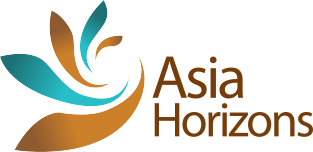OVERVIEW
Destinations: Phnom Penh, Battambang, Siem Reap, Sihanoukville
ITINERARY
12 – Day Trip in Cambodia – 12 Days / 11 Nights
- Afternoon visits
Arrive in the morning – meet with guide for transfer to hotel (check in from 2PM)
Lunch on arrival.
Phnom Penh is the vibrant bustling capital and the largest city of Cambodia, situated at the confluence of three rivers: the mighty Mekong, the Bassac and the great Tonle Sap. Phnom Penh has been the national capital since French colonization of Cambodia and has grown to become the nation's centre of economic and industrial activities, as well as the center of security, politics, cultural heritage and diplomacy of Cambodia.
Once known as the "Pearl of Asia", it was considered one of the loveliest French-built cities in Indochina in the 1920s.
The capital city still maintains considerable charm with plenty to see, reflecting a sort of provincial charm and tranquillity with French colonial mansions and tree-lined boulevards amidst monumental Angkorian architecture. Phnom Penh is a veritable oasis compared to the modernity of other Asian capitals.
Tour orientation and visits:
- the Independence Monument,built in 1958 to memorialize Cambodia's independence from France in 1953. It stands on the intersection of Norodom Boulevard and Sihanouk Boulevard in the centre of the city. It is in the form of a lotus- shaped stupa, of the style seen at Khmer temples and historical sites. The Independence Monument was designed by the Cambodian architect Vann Molyvann
- the Cambodia –Vietnam Friendship Monument, a large concrete monument commemorating the former alliance between Vietnam and Cambodia, built in the late 1970s by the communist regime that took power after the Cambodian-Vietnamese war, which overthrew the Khmer Rouge regime. The monument is located at the Botum Park near the centre of Phnom Penh, featuring heroic statues of Vietnamese and Cambodian soldiers in the “Socialist realist” style developed in the Soviet Union in the 1930s, together with images of a woman and baby representing Cambodian civilians. The monument is in a popular park in the middle of the city.
Transfer back to hotel.
Overnight in Phnom Penh.
- All day visit the capital city of Phnom Penh
Breakfast at hotel.
Proceed to visit Phnom Penh capital city:
- Wat Phnom Pagoda translated as "hill temple" - is the tallest and most important temple in the Cambodian capital of Phnom Penh. The temple, first constructed in 1373, was erected on a man - made, 27-metre-tall mound overlooking the city. It is the tallest religious structure in the city. Legend relates that Daun Penh, a wealthy widow, found a large koki tree in the river. Inside the tree she found four bronze statues of the Buddha. Lady Penh constructed a small shrine on an artificial hill made by the people living in the village to protect the sacred statues. Eventually this became a sacred site and sanctuary where people would make blessings and pray.
- Royal Palace:The Royal Palace of Cambodia is a complex of buildings being built over one century ago to be the royal abode to the King of Cambodia, the royal family and the foreign guests. It is also the place where take place the king’s audience, coronations and official ceremonies. The buildings with beautiful towering spires are a great example of classic Khmer architecture found in Cambodia today.
Along with numerous other interesting buildings within the 183,135 square meters (421m x 435m) compound is the Khemarin Palace, also known as Prasat Khemarin or the "Palace of the Khmer King." This is officially the residence of His Majesty, King Norodom Sihamoni.
The visit to the Royal Palace includes the Throne Hall, the Temple of the Emerald Buddha, Stupas, a Royal Dining Hall, the Chan Chhaya Pavilion and a French-style building that was a gift from Napoleon III French King.
- Silver Pagoda, also called Emerald Pagoda: is located inside the Royal Palace complex. It is called Silver Pagoda as there are 5,329 tiles of silver inlaid on the floor, each tile of silver is handmade and weighs 1,125 grams. The pagoda has a cultural function and keeps precious religious objects more than a place of worship. There are over 1650 valuable objects in the pagoda. The statue of Buddha sit atop throne in the main temple is in emerald.
- National Museum, located at the North of the Royal Palace, is the largest museum of cultural history and is the country's leading historical and archaeological museum.
The museum houses one of the world's largest collections of Khmer art, including sculptural, ceramics, bronzes, and ethnographic objects. The Museum’s collection includes over 14,000 items, from prehistoric times to periods before, during, and after the Khmer Empire, which at its height stretched from Thailand across present-day Cambodia, to southern Vietnam. The Museum buildings, inspired by Khmer temple architecture, were constructed between 1917 and 1924, the museum was officially inaugurated in 1920, and it was renovated in 1968.
- Riverfront Park: The Riverfront Park is located by the concourse of the Tonle Sap, the Bassac and the Mekong and is a remnant of the city’s glamorous past. The park is known for its scenic views and is a terrific place to just relax or take a stroll. The best time to visit is either early in the morning or in the evening; it can get pretty warm in the afternoon. Travellers who are not averse to waking up early should definitely try to catch the sunrise from Riverfront Park. It will undoubtedly be a sight to remember.
- Toul Sleng Genocide Museum which was a former secondary school, was used as the S-21 interrogation and detention center of the Khmer Rouge regime from its rise to power in 1975 to its fall in 1979. Located in the heart of Phnom Penh, it preserves a tragic period in history with the aim to encourage visitors to be messengers of peace.
- Cheung Ek Killing field is the site of a former orchard and mass grave of victims of the Khmer Rouge - killed between 1975 and 1979 – at about 17 kilometres south of the Phnom Penh city centre. It is the best-known of the sites known as Killing Fields, where the Khmer Rouge regime executed over one million people between 1975 and 1979.
Free time for shopping at New Central Market.
Overnight in Phnom Penh.
- Road transfer 300km, 5hrs – Visits: Wat Banan Temple, Prasat Phnom Banan vineyard
Breakfast at your hotel.
Leaving the capital of Cambodia, route to Battambang Province.
Battambang or Krong Battambang (Battambang City) is the capital city of Battambang province in northwestern Cambodia.
Founded in the 11th century by the Khmer Empire Battambang is the leading rice-producing province of the country. For nearly 100 years it was a major commercial hub and provincial capital of Siamese province of Inner Cambodia (1795-1907), though it was always populated by Khmer, with some ethnic Vietnamese, Lao, Thai and Chinese. Battambang remains the hub of Cambodia's northwest, connecting the region with Phnom Penh and Thailand.
The city is situated on the Sangkae River, a tranquil, small body of water that winds its way picturesquely through Battambang province. As with much of Cambodia, French Colonial architecture is a notable aspect of the city, with some of the best-preserved examples in the country. Now the government and Ministry of Culture and Fine Art are preparing documents to nominate The Old Town of Battambang in the list of UNESCO world heritage site along with The Old Town of Kampot and The Old Town of Kratie since 2017.
Lunch in a local restaurant en route.
On arrival, transfer to Wat Banan Temple for a visit.
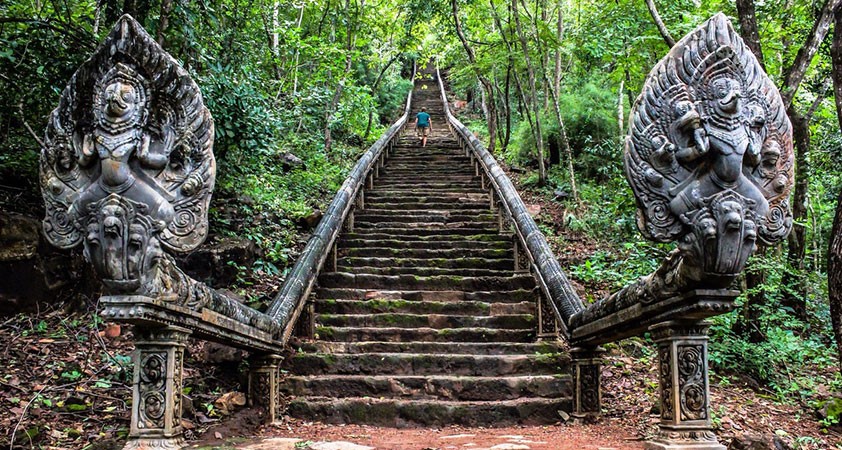
The temple is at Kon Tey 2 commune, Ba Nan district in 25km far from the centre of town and go along the provincial Road No 155 parallel to Sang Kae River.
From outside, the temple looks like be left fallow through many years but in fact, it is used to worship the Gods, the Buddha by native people. Following the path to the top of a mountain, Wat Banan Temple will appear in front of you with an amazing scenery surrounding.
The construction was around mid-11th century to the end of 12th century, went through two reigns of King Ut Tak Yea Tit Tya Varman II (1050 - 1066) and completed by King Jarvarman VII (1181 - 1219).
To get to the Wat Banan, you have to climb approximately 400 meters heighten mountain with around 300 steps but the overview is worth for that. There are stunning 360-degree panoramic views from the top, visitors can see the immense Sang Kae River, thousand sugar palm trees below with rice fields and small villages. But the worthiest is still the amazing old Wat Banan of Angkor-era, the whole temples still keep its origin architecture but like the other ruins in Cambodia, they have been also struggled with extreme looting. There are five temple structures, like Angkor Wat with the middle being the largest. These majestic towers with the carvings of the now headless apsaras on it are the best points in your journey.
Close to Wat Banan is the Prasat Phnom Banan vineyard, the only vineyard in Cambodia, bringing visitors an experience combined visiting the temple to outside activities such as dropping grapes and making vine.
On the way back to your hotel, stop to discover Phsar Nath Market - Battambang Central Market for a while.
Phsar Nath is a market catering for locals, offers a glimpse at what Khmer people purchase and shop for on a daily basis.
Settled in the center of Battambang town, Phsar Nath Market, also known as the Central Market, has drawn tourists’ attractions to the main phsar (traditional market). Phsar Nath is the market catering for locals, offers a glimpse at what Khmer people purchase and shop for on a daily basis. From a great variety of fruits, vegetables, meat, clothes, sundries to food stalls. Like most of Cambodian markets, there are lots of flavors, smells and sights to be taken in. The market is divided into two halves: wet sections with fresh seafood, hanging raw meat and dry sections with fresh fruit, dried seafood.
Check in hotel.
Overnight at hotel in Battambang.
- Road transfer 194kms, 3hrs45mn
Breakfast at your hotel.
Route to Siem Reap. On the way, stop at Preah Netr Preah District of Banteay Meanchey Province to see local families producing stone and wood carve.
Lunch upon arrival Siem Reap.
Siem Reap, which means the “Defeat of Siam”, is next to the Angkor Archaeological Park on the north and Tonle Sap Lake on the south of the city. The charm of Siem Reap lies in a huge selection of best-known places, encompassing the Angkor Night Market where you can find souvenir and art products. Additionally, it is home to a high concentration of alluring café and food culture as well as geared shops that definitely appeal to visitors’ interest.
Check in hotel, them free time to relax and wandering around the town.
Overnight in Siem Reap
- All day visits Angkor Thom & Angkor Wat
Breakfast at hotel.
Proceed to visit Angkor Thom.
Transfer to the ancient city of Angkor Thom – called “the Great City”: after Jayavarman VII recaptured the Angkorian capital from the Cham invaders in 1181, he began a massive building campaign across the empire, constructing Angkor Thom as his new capital city. He began with existing structures such as Baphuon and Phimeanakas and built a grand enclosed city around them, adding the outer moat.
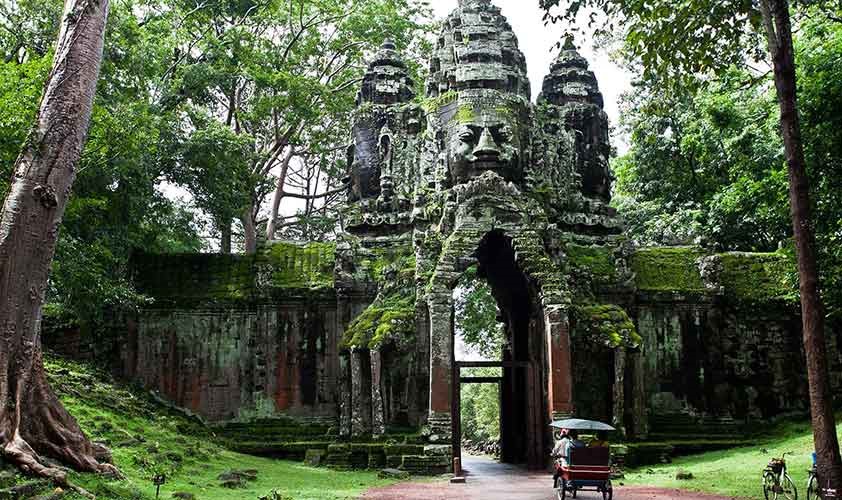
Visits:
* South Gate - the mosted bustling gate as it is the best renovated gate and it leads directly to Angkor Wat.
* Bayon Temple - a buddist temple but it still retains most of elements of the Hindu archeology and imagery.
* Baphoun - a temple built in 1066, before the reign of Jayavarma VII.
* Phimeanakas Temple - located in the middle of the old Royal Palace, symbolizing a Sky Palace and was a place of worship. It means: All of the kings had promoted themselves like the god king’s sons.
* Terrace of the Elephants - served as a viewing platform for royal festivities and depicts elephants and garuda.
* Terrace of the Leper King - The terrace of the Leper King lies just to the north of the Terrace of the Elephants, aligned with it but standing separately. It is named, or rather mis-named, for the seated statue which once occupied the platform and has now been moved to the National Museum in Phnom Penh for safe-keeping. The statue was formerly thought to represent a legendary "leper king," but is now considered to represent Yama, the Lord of the Dead; the terrace itself might have functioned as a cremation platform.
Back to city for lunch.
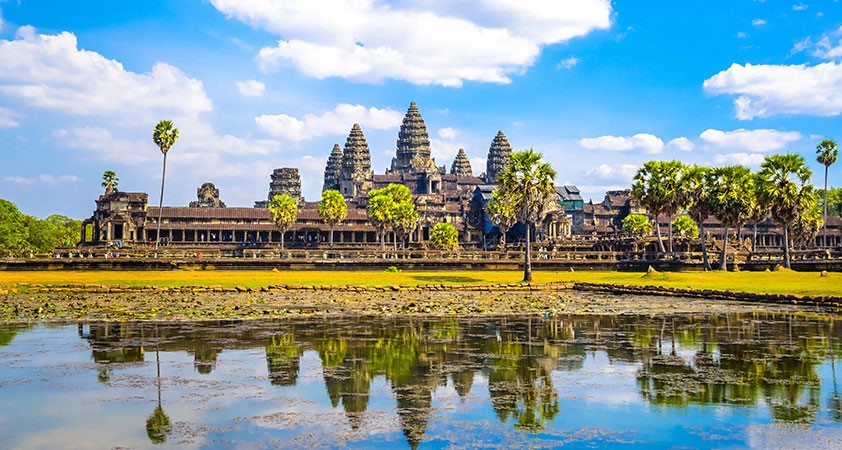
In the afternoon, visit Angkor Wat. The Temple was built during the early years of the 12th century by Suryavaram II and it honored the Hindu god Vishnu before becoming a Buddhist worship edifice in the 16th century.
Climb up Bakheng hill (65m high) and enjoy the sunset over the wonder of Siem Reap at the end of the day.
Transfer back to hotel.
Overnight in Siem Reap.
- Boat trip on Tonle Sap Great Lake, Mechrey floating village & Silk Farm
Breakfast at hotel.
Besides the beautiful temples, Siem Reap has a lot of other interesting sights to offer. On this day tour, make a visit to the Silk Farm to see how silkworms are farmed and silk is harvested. Enjoy the beauty of Cambodia's countryside and visit the Mechrey Floating Village.
Transfer to Tonle Sap Lake wharf.
Enjoy a boat trip on the Tonle Sap lake. This is the largest permanent fresh-water lake in South East Asia and flows into Tonle Sap River, joining the Mekong in Phnom Penh.
Five provinces circled the area of Tonle Sap Lake, more than three million of population inhabited around the bank of the Lake and 90% of them earn a living by catching fish and making agricultures.
Join in a boat trip to Mechrey floating village, a lesser known of all Siem Reap floating villages which is why you will find fewer tourists here. It is 25 km southwest of Siem Reap and is a gateway to a wildlife sanctuary. The ride from Siem Reap to Mechrey is a picturesque one.
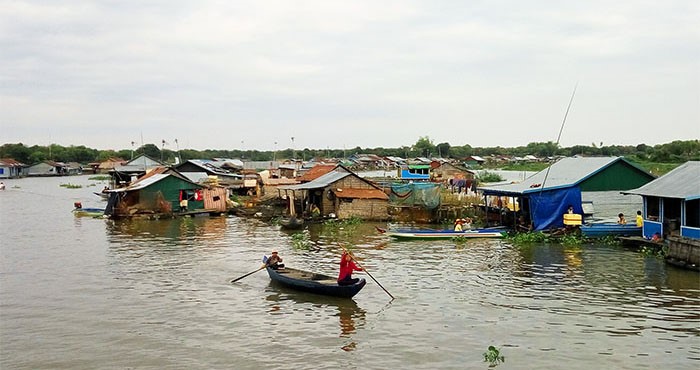
Discover the unique lifestyle of people at this floating village. The front of the floating houses is adorned with beautiful plants and verandas stocked with woodpile. You will even find animals living under the floating houses.
The bizarre attractions of this village are the floating garden and floating cemetery which really look surreal. You can also donate rice to the orphans here and do a good deed.
There is an immense forest area which is a habitat of hundreds of species of birds where you can do some nature photography.
On your way back, visit a silk farm where you can see how worms are raised and how silk scarfs are made and colored, then stop at Artisans Angkor and buy some handicraft souvenirs from your trip.
Transfer back to hotel.
Overnight in Siem Reap.
- Free day
Breakfast at hotel.
Free day to relax by the pool, shopping at local market.
Option: Join in a Siem Reap Quad Bike Adventure bringing you to the authentic and unique beauty of Cambodia which is hidden and unexposed to the world. Freshness and greenery of remote and undisturbed countryside and villages, friendly and smiley people with the sense of welcoming, schools, local orphanages, homes on stills, active Buddhist monasteries along the community, unbeatable sunset at paddy fields and centuries abandoned and untouched ancient Angkorian temples where few travelers and adventures are dare.

You will be picked up from the hotel, then the guide will give you a safety driving, instruction how to drive the quad bike, and will make a short training for the beginner before departure. Riding the road less travelled in rural villages and communities, including a visit to the rice paddy field, water buffalos, Cambodian Buddhism Monastery, and one of less touristic temple which was built before Angkor Wat temple, then take a break for local fresh coconut or cool drink on the way, after a memorable break you will be head back to town.
Overnight in Siem Reap.
- Free days
- Free days
Breakfast at hotel.
Free to swim or organize your days on your own.
Overnight in Sihanoukville.
- Flight for 50mn /or/ Road transfer 3hrs30mn
Arrival Phnom Penh for your flight departure.
